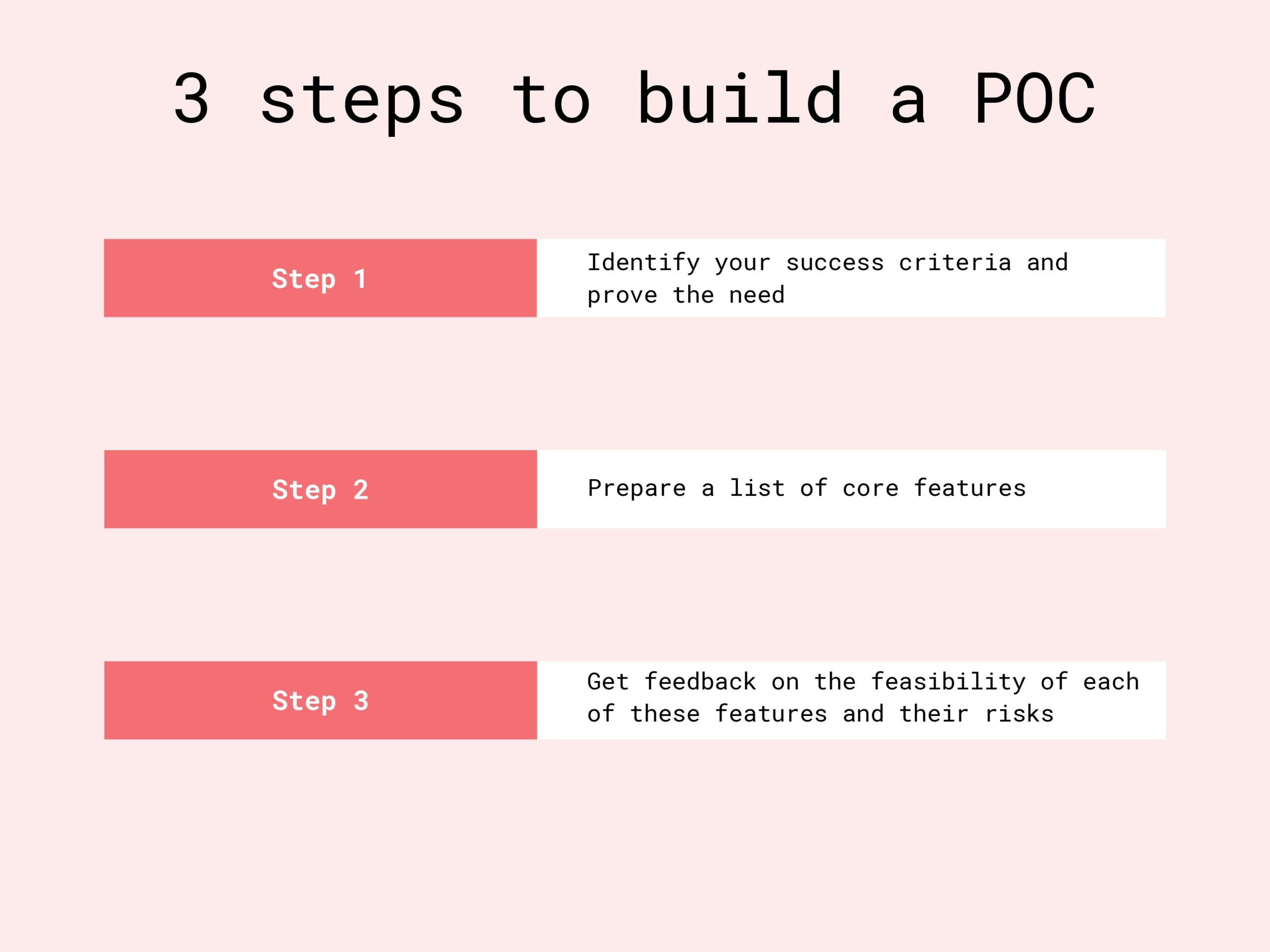In the world of software development, every product starts with an idea that’s later tested and eventually turned into a fully-functional result that can then support real-life users. A Proof of Concept can be seen as the very first step of this process as it serves as a verification method for your initial idea. In the long run, it can save you time and money if your product was not set for success.
At first sight, a POC may look similar to a prototype, Minimum Viable Product, or even a pilot. What makes each of these concepts different, and how to build a helpful Proof of Concept. I’ll explain it in the article below.
What is a Proof of Concept (POC)?
A Proof of Concept essentially “proves” that a certain assumption is correct and can be implemented in real life using available technologies. It serves to answer the question of whether an idea can be realized or not—it’s a bare-bones viability test of your core assumption.
A POC is therefore the first attempt to materialize the operational feasibility of your project.
A POC covers only a part of our future product—usually some crucial element thereof. To test a complex idea thoroughly, you can have many POCs that address each of the core functionalities.
In this model of product development, we’re leaving out the frills: performance, usability, features, and every other customer-facing element are simply not taken into consideration in a POC.
Why Should You Develop a Proof of Concept?
Building a simplified version of your product may seem like an unnecessary step – you can start preparing the real thing after all – but it’s crucial if you want to set yourself up for success and for your final product to be flawless.
Developing a Proof of Concept allows you to test your idea before it turns into a fully-fledged project and to spot – and even resolve – any technical or logistical challenges you may face down the road. This way, you can limit the number of risks for your product, and give stakeholders a chance to review your concept before the development process begins and consequently, save time and money.
Proof of Concept allows both the client and the development team to quickly test some idea or hypothesis without going into a full-scale project. It gives the team time to conduct the research, explore various options, and conclude whether the initial idea would work or not. In Agile terms, one can fail fast and come up with another solution or confirm the initial ideas and start the project with a significantly lower level of risk. Proof of Concept can save time, money, and development effort, while mitigating the risk of building the application only to learn it cannot be launched or has to be completely rebuilt.
In short, Proof of Concept is a way to earnestly say that your idea is valid and worth pursuing further. A functional POC can be an important factor when applying for external funding. A POC is a great way to capture stakeholders and investors for your idea in a relatively short amount of time and with little resources. Entrepreneurs who pursue innovative solutions will also find POCs essential to validating their ideas and assumptions.
Proof of Concept Examples
Say, you have an idea that could revolutionize mobile payments using a specific technology. A POC would test if, for example, a Bluetooth connection could be securely established between a mobile phone and a point-of-sale platform to facilitate hassle-free and fast payments. In other words, a POC checks whether establishing such a connection via Bluetooth is technologically possible.
When trying to break into a heavily competitive app pool, you might need a POC not to test whether an idea is feasible—the competition has already proven that it is—but to check if the unique feature you want to offer your user base can actually be delivered.
Another example will be a POC of a mobile application that would consist of a list of all planned app features categorized by the difficulty of developing them, the competitive advantage that they would give your product, and the risks they convey. This list will be essential for deciding which features to develop first, and which ones can make or break your app. This means that if you want it to succeed, you’ll need to get these elements 100% right.
Proof of Concept vs. Prototype
The difference between a POC and a prototype lies in the purpose of developing both of these projects. The most important question that a POC can help to answer is whether developing your prospective product is feasible and whether you’ll be able to deliver the core functionalities. A prototype is a working, simplified version of the product with the logic between various features already implemented.
Pilot vs. Proof of Concept
Similarly to a prototype, a pilot is a more advanced version of your application. While a POC is built at the pre-development stage, a pilot is an already built product that is now available for testing and collecting feedback from your target users.
Proof of Concept: 3 Steps to Build It

Step 1: Identify your success criteria and prove the need
The first step in developing a favorable Proof of Concept is deciding on how you will measure your success with this project. What are the criteria you should focus on? In software development projects these are usually centered around end users, it’s worth selecting the metrics showing that a POC – as well – as the final product – will be successful in addressing their need(s).
Step 2: Prepare a list of core features
Once you have your success criteria set, the next step will be easy. Simply prepare a list of core functionalities of your prospective product and assess whether it is possible to build them in a timely and cost-effective manner. The list should also include potential threats and opportunities for each of the features.
Step 3: Get feedback on the feasibility of each of these features and their risks
It may happen that you won’t be able to assess every functionality on your own. It’s then worth contacting a team of developers or project managers you’re planning to work on your application.
Summary
As you can see, Proof of Concept is a very useful exercise for software development, but it can be easily applied to almost any other sector. It can serve as a powerful tool for assessing the feasibility of any project.
If you have any questions about the concept or need help with preparing your POC, please do not hesitate to reach out to our teams via
- Contact us
- Phone: +84 888 780 670
- Email: [email protected]




What is a Prototype? Benefits, Types, Examples and Tips – HuviTek
September 24, 2022[…] this part of my product design series about Proof of Concept, Prototype, and Minimum Viable Product, I’m discussing the former concept which can be very […]